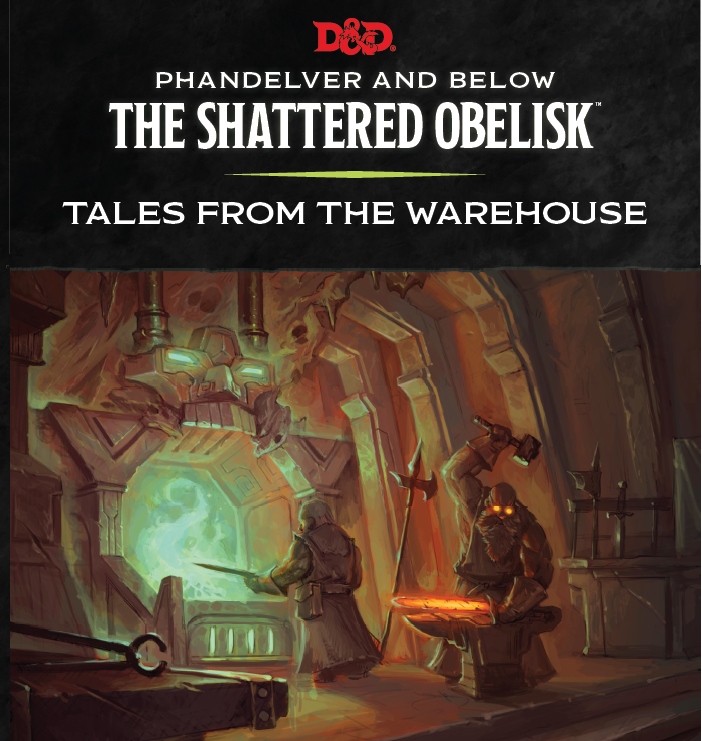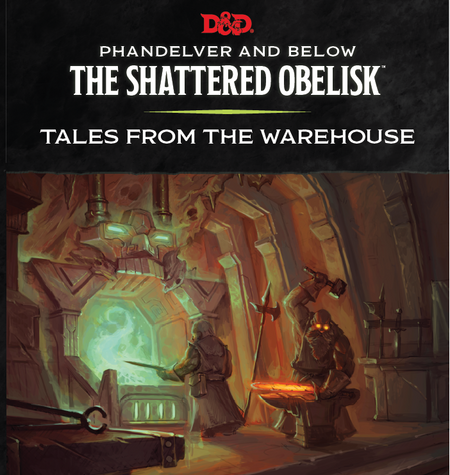
When I DM a written adventure, one of my trickiest tasks is to determine how much I want to make my own. If I alter, add to, or remove from, a carefully written and play-tested adventure, am I risking throwing it out of whack? Making it too easy? Too hard? Cause the party to be distracted from the written adventure’s through line? I’m constantly judging these elements, both in pre-game prep, but also in on-the-fly adjustments.
A staple in Beadle & Grimm’s premium editions is a set of bonus encounters: our Tales from the Warehouse. In concepting and writing those encounters we’re collaborating with Wizards of the Coast to try to minimize any of the risks above. We’re trying to ensure the bonus encounters fit seamlessly into the adventure, are appropriately challenging, and don’t make the players lose the thread of the main quest. I have to imagine other DMs are constantly making these same assessments, both with our bonus encounters, but also their own homebrew alterations.
In Phandelver and Below, there’s plenty of exploration of the Phandalin region - perfect for a bonus encounter or two that a DM can throw in if they feel they want to expand on that section. Session 9 and half of Session 10 of my game were dedicated to the bonus encounter Hobgoblin Siege. While traveling the Triboar Trail, the party must rescue a local Emerald Enclave outpost from marauding hobgoblins.
- I underestimated how long it would take the characters to play out this encounter. I should’ve known. This was a prolonged battle with trained hobgoblin troops, encouraging the party to eliminate small groups of hobgoblins without alerting the other groups. Yeah, that didn’t work out.
- What surprised me is I think my players enjoyed this encounter much more than I did (and I wrote it!). As a DM, I’m more drawn to roleplaying encounters than combat encounters, and this encounter required battle tactics and heavy combat.
- I included a NPC that has a personal relationship to one of my player’s characters as one of the kidnapped and it gave the encounter an extra level of urgency.
Bottom line advice: When you introduce additional content make sure it doesn’t throw the party off of the main quest too dramatically (unless that’s your intention!). I don’t think that happened here because this bonus adventure didn’t really have a loose thread to follow that would distract from their quest to find Cragmaw Castle.
Min-maxing
This party often makes the most of a reach weapon. The paladin uses a glaive (10’ reach, and YES he has the polearm master feat) and, when possible, the party will block a doorway or hallway - the fighter with the best AC in front - and the paladin just behind - it allows only one melee attacker from groups of opponents while the party is able to utilize two melee attackers, providing a key tactical advantage. Additionally, every time an opponent in that narrow space falls and another takes its place, the paladin gets to use his feat to take that opportunity attack when the opponent moves into his space.
Roleplaying the arc
Whenever a player asks me how they can improve their RP, one of the things I remind them of is the character arc. Every great story/movie has 2 arcs - the arc of the plot (i.e. the quest) and the inner arc of the character. Encourage the players to allow for a character arc.
Some players might want to pre-plan this somewhat (“My rogue is going to go from a hard-boiled cad to a soft-hearted hero”) and others might want to adapt their arc to what the adventure brings (“My cleric has hardened from all this time traveling in Avernus”). Ideally, even the player who has pre-planned their arc somewhat finds ways to adjust on the fly to the given circumstances of the adventure.
I find this much more rewarding than if a character starts at level 1 acting like John Wick and ends the campaign at level 10 acting like John Wick.
Look for the change.
The folks at Critical Role do a great job of leaning into long-term character arcs. I try to encourage my players by asking them at key level-ups to: “Describe what has changed in your character as they grow in power.” Just a little nudge to remind them to keep thinking about character arc. But remember, you don’t need a years-long campaign to undergo character change. That can happen in a single session, particularly if a significant emotional event occurs.
Cragmaw Castle
By the end of Session 10, the party had located and entered Cragmaw Castle.
Every party is different - and this party has 2 fighters, a paladin, a combat-focused sorcerer, a warlock, and a ‘crusher’ druid in their ranks. Let’s just say that subtly is not their forte. They have a ‘kick in the door and ask questions later’ mentality sometimes, and that’s okay. I can adjust. This isn’t Tomb of Horrors. It does mean that the campaign is heavy on combat and sometimes I adjust for that so it doesn’t fall too far out of balance.


0 comments